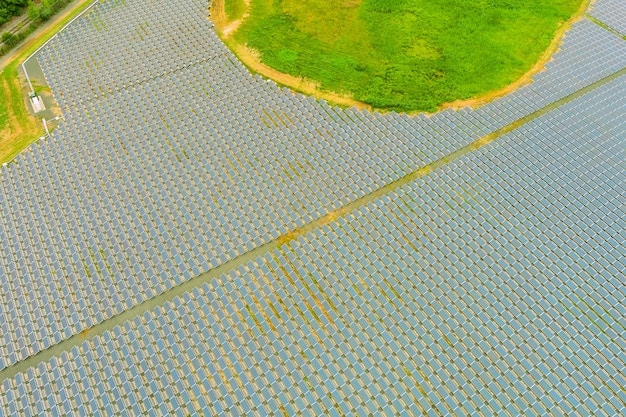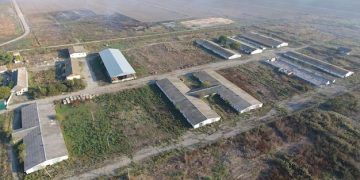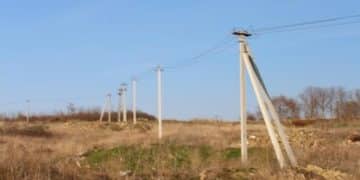FERC’s Proposed Changes: Impact on US Grid Modernization Projects

The proposed changes to the Federal Energy Regulatory Commission (FERC) are poised to significantly impact grid modernization projects by streamlining interconnection processes, fostering competition in transmission planning, and enhancing regional coordination, ultimately aiming for a more resilient and efficient energy grid in the US.
The evolving landscape of energy regulation in the United States is currently witnessing potentially transformative shifts. The proposed changes to the Federal Energy Regulatory Commission (FERC) Affect Grid Modernization Projects by altering the rules and incentives that govern how electricity is transmitted and distributed across the nation.
Understanding the Federal Energy Regulatory Commission (FERC)
The Federal Energy Regulatory Commission (FERC) is an independent agency that regulates the interstate transmission of electricity, natural gas, and oil. Its primary responsibilities include ensuring just and reasonable rates, promoting competition, and protecting the reliability of the energy infrastructure. FERC’s decisions have a profound impact on the development and operation of energy projects throughout the United States.
FERC plays a crucial role in shaping the nation’s energy policy and infrastructure. The commission’s actions influence everything from the prices consumers pay for electricity to the types of energy projects that get built. Understanding FERC’s mandate and its influence on the energy sector is essential for anyone involved in or affected by energy policy.

FERC’s Key Responsibilities
- Rate Regulation: Ensuring that rates for the interstate transmission of electricity and natural gas are just and reasonable.
- Infrastructure Development: Reviewing and approving applications for the construction and operation of natural gas pipelines and electricity transmission lines.
- Market Oversight: Monitoring energy markets to prevent manipulation and ensure fair competition.
- Reliability Standards: Enforcing mandatory reliability standards for the bulk power system.
FERC’s oversight extends to various aspects of the energy sector, making it a key player in shaping the nation’s energy future. By balancing the interests of consumers, industry, and the environment, FERC strives to create a fair and efficient energy market.
In conclusion, FERC’s role is vital for maintaining a stable and competitive energy market. Its responsibilities span from rate regulation to infrastructure development, ensuring that the nation’s energy needs are met in a sustainable and reliable manner.
Key Proposed Changes to FERC Regulations
Several proposed changes to FERC regulations could significantly impact grid modernization projects. These changes are aimed at addressing challenges related to interconnection, transmission planning, and regional coordination, all of which are critical for integrating renewable energy sources and enhancing grid resilience.
These regulatory updates seek to streamline processes and create a more level playing field for clean energy projects. The proposed changes reflect a broader effort to adapt the regulatory framework to the evolving energy landscape and promote a more sustainable and reliable electricity grid.
Interconnection Process Reforms
One of the key areas of focus is reforming the interconnection process, which is often cited as a major bottleneck for new energy projects. The proposed reforms aim to expedite the review and approval of interconnection requests, reduce costs, and increase transparency.
The current interconnection process can be lengthy and complex, often delaying the deployment of new energy projects. By streamlining this process, FERC hopes to encourage more investment in clean energy and improve grid access for renewable resources.
- Standardized Procedures: Implementing standardized procedures for interconnection requests to reduce uncertainty and delays.
- Cost Allocation: Clarifying cost allocation rules to ensure that developers are not unfairly burdened with excessive upgrade costs.
- Increased Transparency: Enhancing transparency in the interconnection queue to provide developers with better visibility into the status of their projects.
Transmission Planning Enhancements
Another important aspect of the proposed changes involves enhancing transmission planning processes. The goal is to ensure that transmission infrastructure is developed in a way that supports the integration of renewable energy and improves grid reliability.
Effective transmission planning is essential for accommodating the growing influx of renewable energy resources. By promoting more forward-looking and coordinated planning efforts, FERC hopes to facilitate the development of a more resilient and efficient transmission grid.
In summary, the proposed changes to FERC regulations are targeted at addressing key challenges in grid modernization. By reforming the interconnection process and enhancing transmission planning, FERC aims to create a more favorable environment for clean energy development and improve the overall reliability of the electricity grid.
Impact on Renewable Energy Projects
The proposed changes to FERC regulations are expected to have a particularly significant impact on renewable energy projects. By addressing barriers to interconnection and improving transmission planning, these changes could help accelerate the deployment of solar, wind, and other renewable resources.
Renewable energy projects often face unique challenges related to intermittency and location. By creating a more level playing field for these projects, FERC aims to promote a more diversified and sustainable energy mix.

Facilitating Interconnection for Renewables
One of the primary ways in which the proposed changes could benefit renewable energy projects is by facilitating interconnection. Streamlining the interconnection process can reduce the time and cost associated with connecting new renewable energy facilities to the grid.
The current interconnection process can be particularly challenging for renewable energy projects, which often face long delays and high upgrade costs. By addressing these issues, FERC hopes to encourage more investment in renewable energy and accelerate the transition to a cleaner energy future.
Improvements to the interconnection process, will create an environment that is more favorable to renewable energy projects, thus easing their integration into the grid. This, in turn, is seen as a step towards meeting broader renewable energy objectives.
Incentivizing Transmission Investments
- Regulatory Certainty: Providing regulatory certainty for transmission investments that support the integration of renewable energy.
- Innovative Technologies: Encouraging the deployment of innovative transmission technologies that can enhance grid flexibility and resilience.
- Regional Coordination: Promoting regional coordination in transmission planning to ensure that renewable energy resources can be efficiently integrated across state lines.
In conclusion, the proposed changes to FERC regulations are expected to have a positive impact on renewable energy projects. By facilitating interconnection and incentivizing transmission investments, these changes could help unlock the full potential of renewable resources and accelerate the transition to a cleaner energy future.
Economic Implications of FERC’s Proposals
The economic implications of FERC’s proposed changes are far-reaching. These changes are expected to influence investment in energy infrastructure, create jobs, and affect electricity prices for consumers and businesses.
By promoting a more efficient and competitive energy market, FERC aims to drive economic growth and create opportunities for innovation. The proposed changes reflect a broader effort to modernize the regulatory framework and ensure that it supports the nation’s economic goals.
Impact on Investment and Job Creation
One of the key economic benefits of the proposed changes is their potential to stimulate investment in energy infrastructure. Streamlining the interconnection process and enhancing transmission planning can reduce the risk associated with new energy projects, encouraging more developers to invest in clean energy and grid modernization.
Increased investment in the energy sector can also lead to job creation, particularly in the renewable energy and construction industries. By supporting the deployment of new energy projects, FERC’s proposed changes could help boost economic growth and create new employment opportunities.
Consumer and Business Electricity Prices
Another important economic consideration is the impact of the proposed changes on electricity prices. While the initial costs of implementing these changes may be significant, the long-term benefits are expected to outweigh the short-term expenses.
- Increased Competition: Fostering competition in the electricity market to drive down prices for consumers.
- Grid Efficiency: Enhancing grid efficiency to reduce transmission losses and lower overall costs.
- Long-Term Savings: Promoting long-term investments in renewable energy and grid modernization to reduce reliance on fossil fuels and stabilize electricity prices.
In summary, the economic implications of FERC’s proposed changes are substantial. By stimulating investment, creating jobs, and promoting grid efficiency, these changes could help drive economic growth and create a more sustainable energy future.
Challenges and Potential Drawbacks
While the proposed changes to FERC regulations are generally viewed as positive, they also present certain challenges and potential drawbacks. It is important to consider these issues and address them proactively to ensure that the changes are implemented effectively.
Some stakeholders have raised concerns about the potential for unintended consequences and the complexity of implementing these changes. Addressing these concerns and mitigating potential drawbacks is essential for ensuring the success of FERC’s modernization efforts.
Implementation Complexities
One of the main challenges associated with the proposed changes is the complexity of implementing them. These changes involve multiple stakeholders and require coordination across different regions and jurisdictions.
The implementation process may also require significant investments in new technologies and infrastructure. Ensuring that these investments are made efficiently and effectively is crucial for realizing the full benefits of the proposed changes.
Stakeholder Concerns
Another challenge is addressing the concerns of various stakeholders, including utilities, developers, and consumer groups. Each of these groups has different interests and priorities, and it is important to find solutions that work for everyone.
- Utility Resistance: Overcoming resistance from utilities that may be reluctant to embrace new regulatory approaches.
- Developer Concerns: Addressing concerns from developers about the costs and risks associated with implementing the changes.
- Consumer Protection: Ensuring that consumer interests are protected throughout the implementation process.
In conclusion, while the proposed changes to FERC regulations have the potential to bring significant benefits, they also present certain challenges and potential drawbacks. Addressing these issues proactively and engaging with stakeholders can help ensure that the changes are implemented effectively and that their benefits are realized.
The Future of Grid Modernization Under FERC’s New Rules
The proposed changes to FERC regulations are expected to shape the future of grid modernization in the United States. By promoting a more efficient, competitive, and sustainable energy market, these changes could help accelerate the transition to a cleaner energy future.
The implementation of these changes will require ongoing collaboration among stakeholders and a commitment to innovation. By working together, industry, government, and consumers can create a more resilient and reliable energy grid that meets the needs of the 21st century.
Long-Term Vision
Looking ahead, the goal is to create a grid that is capable of supporting a wide range of energy resources, from large-scale wind and solar farms to distributed generation and energy storage systems. This will require a fundamental shift in the way the grid is planned, operated, and regulated.
The proposed changes to FERC regulations are a step in the right direction, but more work remains to be done. Continued innovation and collaboration is essential for realizing the full potential of grid modernization.
With the right policies and incentives, the United States can build a grid that is more resilient, efficient, and sustainable. This will not only benefit consumers and businesses but also help the nation address the challenge of climate change.
Policy Recommendations
- Regulatory Coordination: Enhancing coordination among federal, state, and local regulatory agencies to ensure that grid modernization efforts are aligned.
- Technology Innovation: Incentivizing technology innovation to drive down the costs of grid modernization and improve performance.
- Public Engagement: Engaging the public in the grid modernization process to build support for these efforts and ensure that consumer interests are represented.
In summary, the future of grid modernization under FERC’s new rules is bright. By promoting innovation, collaboration, and a long-term vision, the United States can build a grid that is more resilient, efficient, and sustainable, and that meets the needs of consumers and businesses for generations to come.
| Key Point | Brief Description |
|---|---|
| ⚡ Interconnection Reforms | Streamlining processes for renewable energy projects to connect to the grid faster. |
| 💰 Economic Impacts | Potential job creation and investment driven by grid modernization projects. |
| ☀️ Renewable Integration | Supporting the integration of solar, wind, and other renewable resources. |
| 🛡️ Grid Resilience | Enhancing the grid’s ability to withstand and recover from disruptions. |
Frequently Asked Questions
▼
FERC is a US agency that regulates the interstate transmission of electricity, natural gas, and oil, fostering competition and ensuring reasonable rates.
▼
FERC’s rulings determine the cost of energy transmission, influencing rates and the availability of energy resources for households and businesses.
▼
The changes aim to enhance interconnection processes, transmission planning, and regional collaboration for a more reliable grid with more renewable sources.
▼
The reforms should lower project delays and connection costs, spurring growth in US solar, wind, and other renewable market sectors.
▼
Challenges include complex implementation, stakeholder disagreement, and potential disruption to existing grid operations, requiring cautious planning.
Conclusion
In conclusion, the proposed changes to the Federal Energy Regulatory Commission (FERC) represent a significant step towards modernizing the US energy grid. While challenges remain, the potential benefits of these changes, including increased renewable energy integration, economic growth, and improved grid resilience, make them a critical component of the nation’s energy future.





